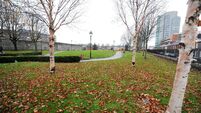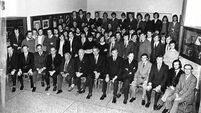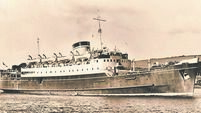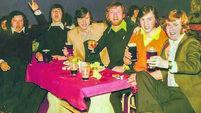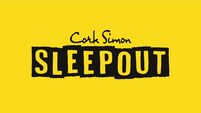Recognise any faces in this 1936 Cork photo?
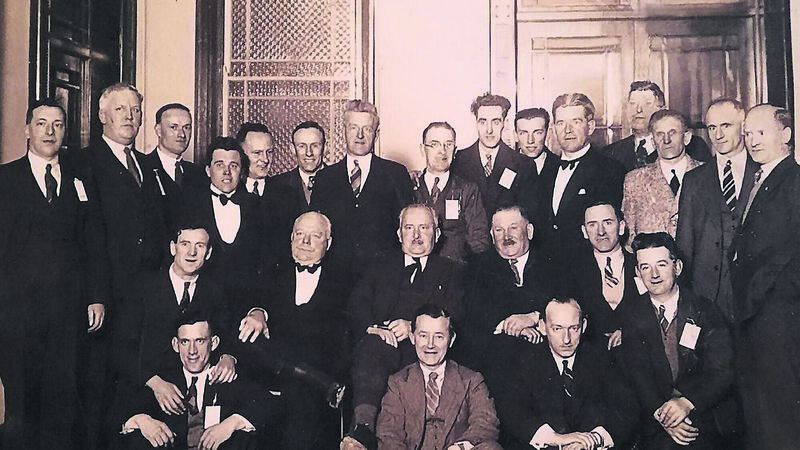
A group of men at the possible opening of the new City Hall in Cork around 1936. Can you identity any of the faces? Picture supplied by Martin Byrne
READER Martin Byrne has paid tribute to this weekly, Throwback Thursday page and the fascinating information it unearths from contributions, by writing to ask if we can assist with a problem of identification that he and a friend have been experiencing.
“I’m hoping yourself and your readers might be interested in assisting with the following. A neighbour of mine has for some time now been trying to find the identities of the individuals in this photograph (main photo on facing page).
“With that in mind, he has asked that I approach you in the hope you might feature it in one of your excellent Thursday pages.
“In doing, so he has high expectations that some of your regular readers might be able to put names to the faces of the men in the image.
"Being a regular reader of your pages I think his quest fits quite well with the topics of local history that your articles cover so well.
Martin adds: “I’ll tell you what my neighbour has discovered so far from various sources. He believes the photograph was taken at the time of the opening of the new City Hall in October, 1936. Members of the recently established Cork City Old IRA Men’s Association met with President de Valera on that occasion. Thus, various city dignitaries, TDs and Old IRA men make up the bulk of the people in the shot.”
Martin says his neighbour believes he can identify ten of the 24 people here, namely Hugo Flynn, Tadgh Manley, Flor O’Donoghue, Gus Healy, Michael Kenny, Michael Corry, Tom Crofts, Michael Baylor, Pa McGrath, and Jim ‘Tough’ Barry.
So the challenge, states Mr Byrne, lies in identifying the remainder, and indeed confirming the identity of those they think they know, as well as confirming that it was indeed taken at the opening of the new City Hall.
“Close inspection of the image highlights that some men are wearing labels or tags on their jackets, while some are not. Some are wearing bow ties, but most are not. Were the tag wearers stewards of some sort, perhaps?
In the event of any readers being able to name those as yet unidentified, Martin pleads that they would list where exactly these are positioned in the image as this would be extremely helpful.
Well, gang, it’s up to you now. Out with those magnifying glasses and look long and hard! We have a great reputation here for solving mysteries and must keep it up!
Pat Kelly, that great recorder of times past and local history, who thankfully has made such a successful recovery from a brain tumour, writes to say he has enjoyed very much the contributions concerning the old railway lines and the Cork city termini.
“I just wanted to point out that for a short time, the terminus for the Dublin route was at Kilbarry in Blackpool, as the tunnel had not yet been completed,” he said. “That tunnel had to be dug at a gentle curve, and the platform was also built to the same curve, to tie in with the former track of the Summerhill line, with a bridge built over the Lower Glanmire Road.”
And Pat has a nice story to contribute which combines memories from several different Throwback Thursdays, notably horse-drawn vehicles and Thompson’s cakes!
“In a recent Throwback Thursday, you had a photo of Sts Peter and Paul’s with Guys on the left and what became Thompsons restaurant on the right. The restaurant, with its prim waitresses in starched aprons and little caps, was where one could also buy cakes for take-away. Just around the corner, between the back of Thompsons and the church, was a tiny shop where deliveries were made, and the takeaways were sold there.”
At one time, recalls Pat, Thompsons had some electric-like milk floats. Steve, one of their drivers, would make his deliveries at the back door/shop, leaving the doors of the float open while he hurried in and out with boxes.
One morning, however, he came out to discover a horse and cart had been parked behind the float. Well, if you were a hungry horse and the delicious aroma of freshly-baked chocolate slices and lemon buns came to your nostrils, what would you do? The sensible equine had moved slowly forward, put its head into the delivery van, and happily proceeded to have a second breakfast. Most of the contents were gone by the time Steve discovered the outrage.
Can’t you hear that horse mumbling through a mouthful of crumbs as he is firmly moved on to fulfil his daily duties?
“That slice was nice but not enough of it. Wonder if they’re still making those little round chocolate tarts? Must check for them tomorrow…”
Then it was the front pages of this paper that brought up some more memories from Pat’s mental archives. It was a headline feature about the proposed changes to Coburg street, a place he knew intimately.
“The city limits were once at Fitzgeralds Bakery. There was a blocked tunnel here, and a bunch of the lads took some blocks out, and climbed into the tunnel to see where it led. According to them, it emerged at Patricks Hill, and Hardwick street.”
Now that is really interesting, Pat. Wonder what its purpose was? Or could it have been a lost lane? Any other opinions welcomed!
“The cafe at the corner of Coburg Street, Devonshire Street, and Leitrim Street was once a shop that repaired vacuum cleaners,” recalls Pat. “And on the right, in Devonshire Street, was John Creedon’s family shop. On the right in Leitrim street was a milk and odds shop, where we would have a cup of tea and a Thomsons cake from Denis and Noreen.
“To the left side of the Comedy Club was a pub, the Iveleary, and nearer to Bridge Street and the bottom of Patricks Hill was the barber shop of Tommy O’Sullivan, and his son, Jimmy, who had appeared on a TV programme, would you believe, cutting MY hair!
“There was a spice shop too, I think it was Irene’s. And at the corner of Bridge street and MaCurtain Street was Paddy Barry’s pub. That once was a shop that sold lawnmowers and chain saws. I think that was O’Sullivan’s.”
Pat is still hoping to hear from anyone who can recall the ship that ran aground near Raffeen, a happening witnessed by him back in the 1960s.

Well, we have good news for you, Pat! Frank Roche has sent us some wonderful clippings from the Echo of March 9, 1962, detailing that very event and with a picture. Thank-you so much, Frank! Clearly your research skills are way up on ours!
Well, we knew De Echo would have it, really, didn’t we? How could anything happen in Cork and De Paper not know about it?
Frank Roche has also contributed some ideas on the topic of that mystery photograph of one Kate Davies, taken on North Mall some time in the 1880s or thereabouts, but space does not allow us to give that full prominence this week. So, next week, OK?
Pat Kelly concludes: “Thanks for the memories of a city that is gone, where we had nothing, but we had everything, whereas present-day children have everything, but have nothing of the memories that the older generation treasure.”
Too true, Pat. Let’s hear more from everyone with golden recollections of Cork childhoods.
Bill Murphy read the account of pilgrimages to Knock, in last week’s Throwback Thursday, with sharp recognition.
“Religion never sat easily with me, and maybe for that reason I was taken to Knock as a young boy,” said Bill. “I’d say we boarded the train in Fermoy at first light, then to Mallow and lots of stops thereafter.
“What I most remember were the innumerable rosaries on the train up and down. If there was any pause at all, someone would suggest saying another rosary.
“I have no memory much of Knock itself, I think it was raining. I’m sure I went to sleep eventually on the way down.”
Well, it was certainly a time when the church ruled the country, and everyone was under a firm clerical thumb. Does anyone remember the ‘Stations’ which were an occasion when Mass was said in private houses around the rural areas, all the neighbours for miles around gathering to observe the occasion and get a good look at the individual hostess’s private life? The whole place had to be scrubbed, whitewashed, cleaned, baking went on for days, stress levels reached screaming pitch. But it was something that had to be done, and woe betide the housewife who tried to opt out of the obligation.
Any readers have memories of those demanding events? Let us know if you do. It always seems to have been the responsibility of the womenfolk. Probably the menfolk seized the opportunity to slide out the back door, rather as you would see at crowded little churches on Sunday mornings, all the women packed into the pews, and the men and boys out in the porch gossiping and relaxing.
“Sure as long as we leaned against the wall of the place we were getting the Mass in all right,” was one old man’s recollection.
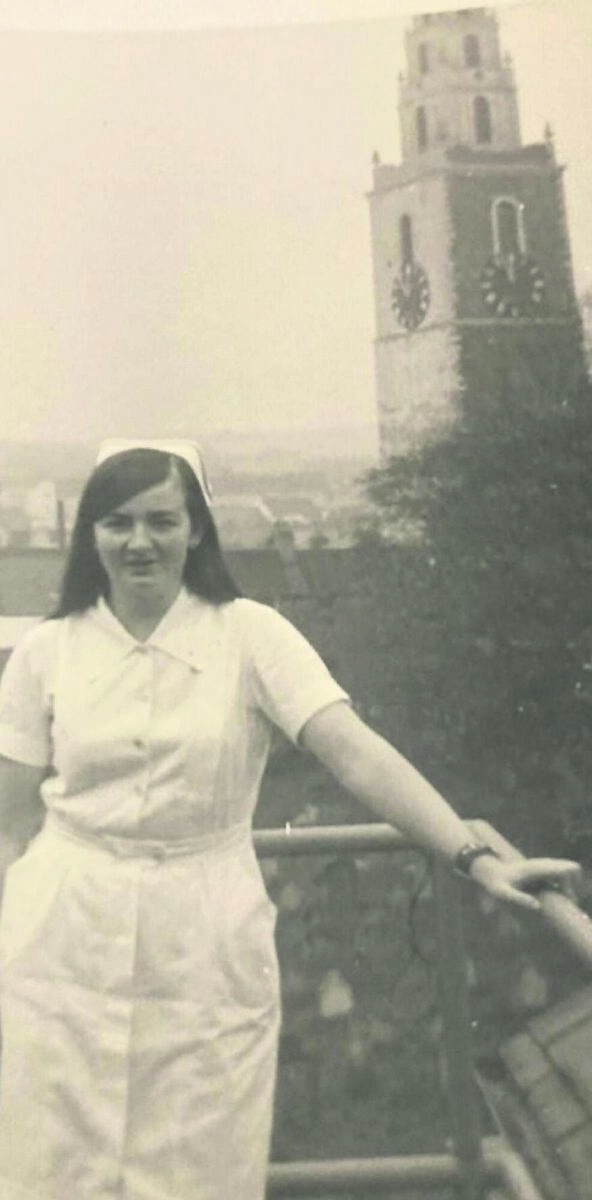
Finally, Mary Holly has sent us pictures of a neighbour who was a nurse up at the North Infirmary in her young days.
“Mary McCarthy (nee Hallissey) is originally from Kilbrittain, and trained as a nurse in the North Infirmary. These photos were taken on the roof of the hospital.
"The nurses used to take their breaks there in fine weather to get some fresh air and sunshine. This view of Shandon is, alas, no more.”
Ah, the North Infirmary. Now there is a building with a history. One would not be in the least surprised to find that modern-day guests at the elegant Maldron Hotel hear unexplained footsteps, strange voices in the corridors. If ever a place was haunted by the past, it has to be this one.
Opened as a free hospital for the poor of Cork in 1720 (and built of those yellow bricks which arrived in such huge amounts as ballast in ships berthing in our docks), it somehow survived, though always strapped for funding, right through the War of Independence, the Civil War, and World War II.
In troubled times, wounded volunteers were often secretly smuggled in by a back door for treatment before being smuggled out again.
Where once it healed the sick and suffering, it now cares for the comfort of wealthier guests. But what memories it must hold!
Let us hear your memories. Email jokerrigan1@gmail.com or leave a comment on our Facebook page: https://www.facebook.com/echolivecork.
